Behind every no-show isn’t just an empty chair, it's a missed opportunity for a diabetic patient to adjust their medication, a delayed cancer screening, or a parent who couldn’t bring their child for a check-up. Multiply that across the system, and no-shows become more than an inconvenience they become a public health risk
No-shows create three major challenges for healthcare providers: lost revenue, disrupted workflows, and lower patient retention. The traditional methods of reminder calls and postcards aren’t enough anymore. AI is emerging as the game-changer that not only predicts no-shows but also prevents them before they happen.
The Hidden Cost of Patient No-Shows
When a patient skips an appointment, it may look like just one empty slot. In reality, it creates a chain reaction:

-
Lost Revenue: A single no-show costs providers an average of $200+ per visit,adding up to the $150 billion annual drain on the U.S. healthcare system.
-
Clinical Risk: For chronic care patients, one missed check-up often snowballs into worse outcomes. In fact, they’re 70% more likely not to return within 18 months—a silent but costly attrition.
-
Operational Headaches: Instead of focusing on care, staff spend hours chasing patients, juggling schedules, and filling last-minute gaps.
And here’s the part most practices don’t realize: no-shows don’t just waste today’s slot they often mean a lost patient for good.
How to Calculate No-Show Rate
Calculating your no-show rate is simple and essential for tracking your clinic's performance. Here's how you can calculate it:
No-show Rate = (Total Missed Appointments / Total Scheduled Appointments) × 100
For example, if you scheduled 100 appointments and 25 were missed, your no-show rate would be:
By calculating and regularly monitoring your no-show rate, you can assess how well your current reminders and scheduling systems are working and make informed decisions about improvements.
Practical AI Strategies to Prevent Patient No-Shows (with Evidence)
Providers who want to cut down no-shows can focus on these AI-driven strategies, which are supported by research findings from the National Institutes of Health (PMC article):
1. Predictive Analytics to Identify At-Risk Patients
-
How it works: AI risk-scores patients based on demographics, appointment history, and behavioral patterns.
-
Why it matters: Research shows that no-show rates vary widely, from 5% to 55%, and are higher among underserved populations. Predictive tools help clinics identify which patients are at higher risk and proactively reach out.
-
Benefit: AI can reduce no-show rates by up to 38% by targeting reminders and interventions to the patients most likely to miss appointments.
2. Dynamic Waitlist Automation
-
How it works: Open slots from no-shows are automatically offered to other patients waiting for earlier appointments.
-
Evidence: The PMC article highlights that missed appointments lead to wasted staff time and underutilized resources. Dynamic waitlists help clinics maintain full schedules and minimize operational inefficiencies.
-
Benefit: No more wasted time slots and higher patient throughput without extra staff work.
3. Personalized Multi-Channel Reminders
Instead of generic reminders, AI customizes messages:
-
Your cardiology check-up with Dr. Khan is tomorrow at 10 AM. Please bring your test results
-
Your diabetes check-up is scheduled for tomorrow—don’t forget your glucose log.
The PMC article points out that forgetfulness is a major patient-related cause of no-shows. Personalized, timely reminders address this root cause.
4. Conversational AI for Seamless Rescheduling
Patients can quickly reschedule via SMS, WhatsApp, or phone bots, and get answers to common questions. By addressing transportation and scheduling conflicts, AI reduces missed appointments while easing staff workload and boosting patient satisfaction.
5. Smart Dashboards and Workflow Automation
AI delivers real-time insights on no-show patterns, cancellations, and staff utilization. By optimizing schedules, it reduces operational inefficiencies, eases staff workload, and improves overall workflow efficiency.
Quick Tips to Reduce No-Show Appointments (Evidence-Backed)
Here are additional evidence-based tips from research combined with AI applications:
Automate Reminders: SMS, email, or automated calls significantly reduce forgetfulness (a leading cause of no-shows).
Personalize Communication: Include appointment details and patient-specific instructions; patients are more likely to attend when messages feel relevant.
Provide Self-Scheduling: Allow patients to reschedule online to reduce conflicts and cancellations.
Offer Telehealth: Research shows that transportation and logistical barriers are major no-show contributors. Virtual appointments remove these obstacles.
AI Strategies to Handle Patient Cancellations
Automate Rescheduling:
Patients can easily reschedule via automated follow-ups, reducing staff burden.
Offer Telehealth Options:
Virtual appointments lower the risk of cancellations due to transportation or timing issues.
Implement a Cancellation Policy:
Including fees for last-minute cancellations encourages commitment.
Follow-Up After Cancellations:
Contact patients to reschedule and understand reasons for cancellations.
Streamlining Workflows and Boosting Efficiency
AI not only improves attendance but also relieves staff:
-
Automated check-ins reduce front-desk bottlenecks.
-
Dashboards provide visibility into no-show trends.
-
Workflow automation cuts down repetitive admin tasks.
-
Predictive overbooking ensures slots aren’t wasted while avoiding overcrowding.
This means less stress for staff and more time for patient care.
Data Privacy and Compliance
El Rio Health, a Federally Qualified Health Center (FQHC), faced high no-show rates.
Solution:
-
Implemented CareSignal, an AI-powered automated reminder system with voice and SMS.
-
Two-way communication allowed confirmation, rescheduling, or cancellation.
-
Integrated with EHR for automatic updates.
-
Predictive capabilities flagged high-risk appointments.
Results:
-
32% decrease in no-shows
-
$100K monthly revenue increase
-
40% reduction in administrative workload
How Providers Can Apply This in Their Practice
-
Integrate AI: Add AI-powered tools to predict no-shows in your practice. Start by using models that analyze patient scheduling patterns and behavior.
-
Personalize Communication: Use AI to send targeted reminders and follow-ups based on patient behavior and history.
-
Save Time and Boost Revenue: By reducing no-shows, you can optimize your practice's scheduling, improve efficiency, and boost revenue.
The Key Benefits of AI for Providers
Here’s how AI can transform your practice:

-
More reliable schedules with fewer empty slots
-
Higher revenue from optimized patient flow
-
Better outcomes as chronic patients keep attending
-
Less admin burden for staff, allowing more focus on care
-
Stronger retention as patients feel valued and connected
Actionable Steps to Stop No-Show Appointments
-
Track and Monitor No-Show Data: Regularly track your no-show data to identify patterns and predict future no-shows.
-
Send Multi-Channel Reminders: Ensure reminders reach patients via SMS, email, and automated phone calls.
-
Incentivize Attendance: Offer small incentives, such as discounts on future appointments or loyalty programs, for patients who attend their scheduled appointments.
-
Confirm and Reschedule Early: Reach out to patients who are at risk of missing their appointments, providing them easy options to reschedule well in advance.
Final Takeaway
Patient no-shows aren’t just inconvenient; they drain revenue, overwork staff, and compromise care. AI provides a proactive, data-driven solution by predicting risk, automating scheduling, and engaging patients on their terms.
For providers, adopting AI isn’t optional anymore. It’s the path to reducing no-shows, improving efficiency, and strengthening patient relationships in 2025 and beyond.
👉 Ready to safeguard your schedules and revenue? Book a consultation with HMS today and explore how AI can transform your practice.
ABOUT AUTHOR

Danial Garcia
As a blog writer with years of experience in the healthcare industry, I have got what it takes to write well-researched content that adds value for the audience. I am a curious individual by nature, driven by passion and I translate that into my writings. I aspire to be among the leading content writers in the world.
